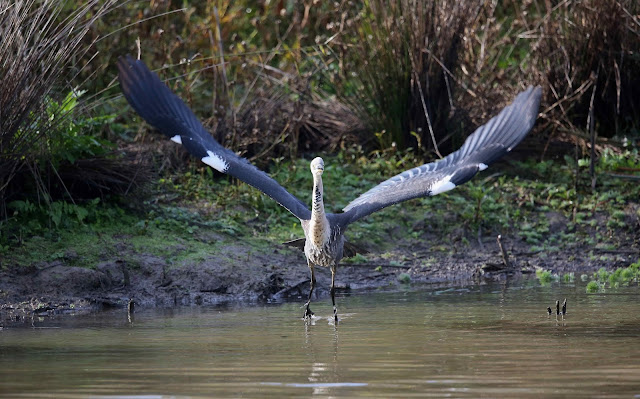White-necked
Herons (Ardea pacifica) are nomadic and
can be found right across Australia wherever there is water, including the arid
inland. They also have regular winter-spring movements in some regions, so are
also migrants. Following good rains across the arid interior, they will exploit
ephemeral water. However during prolonged and widespread inland droughts they
will head to coastal areas to take refuge.
As a consequence,
White-necked Herons come and go from East Gippsland as do many other waterbird
species. They were absent from East Gippsland over the past summer however some
birds returned during autumn. I recently found one hunting for small fish in
the Sale Common wetland.
To start the
photos in this post I have included some from Ormiston Gorge in the West
MacDonnell Ranges NT to show the large range of habitats exploited by the
White-necked Heron.
Please click on photos to enlarge.
 |
| Ormiston Gorge - this desert waterhole habitat could not be more different from the Sale Common wetlands. |
 |
| One of five White-necked Herons on the rocks above a water hole in Ormiston Gorge. |
 |
| This bird was hunting fish along the rocky edge of the gorge. |
 |
| A dingo was looking for food along the waterhole – it eventually walked close behind me as I watched the White-necked Herons on the other rocky side of the gorge. The dingo found a freshly dead fish in reeds about 6 metres from me. |
 |
| The heron plucked a live fish from the waterhole just as the dingo found its fish breakfast among reeds no more than 10 metres away. |
Returning
to Sale Common:
I was not
far into the wetland when I came across a Great Egret (Ardea modesta – the same genus as the White-necked Heron) hunting
among Giant Rush (Juncus ingens).
 |
| Great Egret hunting in Giant Rush at Sale Common. |
 |
| The bird has a long and strong neck and a formidable dagger bill. |
Further along
I came across an adult White-necked Heron in non-breeding plumage stalking along
the water’s edge and watched it capture several very small fish all about 2 centimetres
long at most.
 |
| White-necked Heron, adult – the dark spots on the neck indicate non-breeding condition. |
 |
| The heron has caught something small? |
 |
| The heron glanced my way from time to time to make sure I was not a threat. |
 |
| The heron continues to look for more prey – at times it is poised motionless with eyes in concentrated focus. |
 |
| Finally I captured a photo showing a small fish – the other fish caught were swallowed very quickly – too quickly to capture with the camera. |
 |
| The heron continued hunting. |
At this
point, the Great Egret which I had seen hunting earlier some distance away and
out of sight of the White-necked Heron, suddenly appeared.
 |
| The Great Egret strode with purpose across the water to the shore where the White-necked Heron was hunting. |
 |
| The Egret approached the Heron with purpose – it was clear to me the Egret was asserting control over this hunting territory. |
 |
| As the egret closed in the heron moved away. |
 |
The smaller White-necked Heron gave way to the larger Egret and took to the air.
They have a remarkably wide wingspan.
|
About 100
metres further along the same stretch of water a White-faced Heron was hunting
small fish. The fish looked to be about the same size as the ones the
White-necked Heron was taking.
 |
| A small fish is just visible near the tip of the heron’s bill. |
 |
| An Azure Kingfisher flew in to hunt on the same fallen tree as the White-faced Heron. |
The 45 minute
stroll in a small section of Sale Common yielded plenty of action and interest
including the resolution of a minor territorial dispute.



















No comments:
Post a Comment